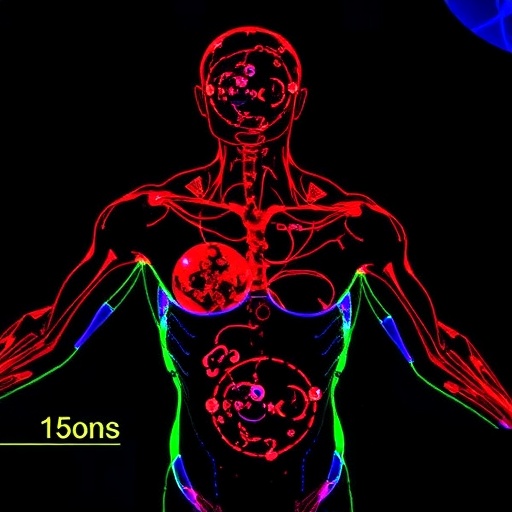
In a groundbreaking advancement for the treatment of muscular dystrophies, a team of researchers has unveiled a novel molecular technology capable of dramatically improving the targeted delivery of therapeutic agents to damaged muscle tissue and the heart. The innovation centers on a synthetic peptide, designated DG9, which has been shown to significantly enhance the nuclear uptake of phosphorodiamidate morpholino oligomers (PMOs). These PMOs are antisense molecules designed to promote exon skipping—a critical mechanism that allows the restoration of functional dystrophin protein expression in cells affected by dystrophic diseases. The research, published in Nature Communications, represents a pivotal step toward more effective treatments for debilitating conditions such as Duchenne muscular dystrophy (DMD).
Exon skipping serves as a molecular workaround for genetic mutations that disrupt the dystrophin gene, which encodes a key structural protein that maintains muscle fiber integrity. In DMD patients, mutations lead to the absence or dysfunction of dystrophin, causing progressive muscle degeneration and ultimately life-threatening cardiac complications. The therapeutic principle involves using antisense oligonucleotides like PMOs to guide the cellular machinery in “skipping” over faulty exons during the mRNA splicing process. This results in the production of a truncated yet functional dystrophin protein capable of partially restoring muscle function. However, a significant hurdle in translating exon skipping therapies to clinical success has been the inefficient delivery and uptake of PMOs into muscle nuclei, limiting their therapeutic efficacy.
Shah, Wilton-Clark, Haque, and colleagues have developed DG9, a novel peptide conjugate designed to surmount the intracellular barriers that have long constrained PMO effectiveness. The team engineered DG9 to facilitate enhanced permeability and nuclear localization, thereby improving the transport of PMOs into dystrophic muscle cells. This conjugation allows the PMOs to evade degradation and intracellular sequestration, increasing their bioavailability within the nucleus where exon skipping occurs. The peptide exploits specific cell-penetrating mechanisms and nuclear targeting sequences, enabling superior delivery compared to previous agents.
Through rigorous in vitro experimentation, the authors demonstrated that DG9-conjugated PMOs exhibited significantly increased nuclear concentration in cultured myoblasts and cardiomyocytes derived from DMD models. These findings were complemented by in vivo studies using dystrophic mouse models, which revealed a remarkable improvement in functional outcomes. Treated animals showed enhanced dystrophin production in skeletal muscles and cardiac tissues, supported by histological and molecular assays that confirmed the precise exon skipping events facilitated by the DG9-PMO complex.
Functional evaluation of muscle physiology in treated animal models yielded highly encouraging results. Improvements in muscle strength, endurance, and resistance to injury were observed following systemic administration of DG9-PMO conjugates, surpassing those achieved by current antisense therapies. Cardiac function, often overlooked in dystrophic studies, showed marked recovery, which is particularly significant given the lethal cardiomyopathy associated with advanced DMD. Measurements of cardiac output, ejection fraction, and histopathological assessment indicated that DG9-boosted exon skipping mitigated both muscle wasting and fibrotic remodeling.
At the molecular level, DG9 operates via enhancing PMO stability in the circulatory system and orchestrating their trafficking to muscle cell nuclei. The peptide’s design was informed by structural motifs known to traverse cellular membranes and disarm intracellular degradation pathways. This bioengineering approach underscores the importance of rational peptide design in overcoming fundamental obstacles faced in nucleic acid therapeutics. Notably, DG9 conjugation did not elicit detectable toxicity or immune responses in treated subjects, suggesting a favorable safety profile to support further development.
What differentiates this approach from prior efforts is the dual benefit of improved delivery efficiency and sustained exon skipping activity, which translates to durable restoration of dystrophin. Previous PMO therapies have often been limited by the transient nature of the antisense effect and the challenges of dosing. DG9’s enhancement in nuclear uptake means fewer doses at lower concentrations may be required to maintain therapeutic levels, potentially improving patient compliance and reducing treatment cost burdens.
Moreover, the implications of DG9 technology extend beyond muscular dystrophies. The principles of targeted nuclear delivery via peptide conjugation could be adapted for diverse antisense and gene-editing therapeutics aimed at other genetic disorders involving faulty nuclear RNA processing. The versatility of PMO scaffolds combined with DG9’s delivery capability opens an expansive horizon for genetic medicine, especially in conditions where tissue targeting and nuclear uptake have been limiting factors.
The researchers emphasize the translational potential of their findings, outlining plans for clinical development and scale-up synthesis of DG9-conjugated PMOs. Preclinical toxicity and pharmacokinetic profiling will be crucial next steps, alongside establishing optimal dosing regimens in larger animal models. Given the chronic nature of muscular dystrophies, long-term safety evaluation is equally imperative before advancing to human trials.
This breakthrough arrives at a time when the therapeutic landscape for muscular dystrophy is rapidly evolving, with exon skipping emerging as a critical modality alongside gene replacement and editing strategies. The DG9 system, by overcoming delivery constraints, may well become a cornerstone enabling antisense therapies to achieve their full clinical potential. Scientists and clinicians alike are hopeful that such improvements will meaningfully delay disease progression and improve quality of life for affected individuals.
Public health impact cannot be overstated—DMD affects thousands worldwide, resulting in severe disability, cardiac complications, and early mortality. Current treatment options are limited and largely supportive rather than curative. Innovative delivery approaches like DG9 hold promise to revolutionize therapeutic outcomes, shifting the paradigm toward molecular correction of the underlying genetic defect.
In summary, the report by Shah and the team presents a compelling advancement in oligonucleotide therapy through the use of DG9 peptide conjugation. By markedly increasing nuclear uptake and exon skipping efficiency of PMOs, they have laid a foundation for next-generation treatments capable of restoring muscle and heart function in dystrophic conditions. The findings provide hope that molecularly targeted, safe, and effective therapies will soon be within reach for patients burdened by devastating genetic muscle diseases.
As the field eagerly awaits validation in clinical contexts, this research underscores the transformative power of integrating peptide delivery systems with antisense technology. It marks a bold stride forward in the quest to tame the complex biology of muscular dystrophy and exemplifies the innovative spirit driving precision medicine in the post-genomic era.
Subject of Research: Enhancement of phosphorodiamidate morpholino oligomer (PMO) delivery for exon skipping to restore dystrophin expression in dystrophic muscle and cardiac tissue.
Article Title: DG9 boosts PMO nuclear uptake and exon skipping to restore dystrophic muscle and cardiac function.
Article References:
Shah, M.N.A., Wilton-Clark, H., Haque, F. et al. DG9 boosts PMO nuclear uptake and exon skipping to restore dystrophic muscle and cardiac function. Nat Commun 16, 4477 (2025). https://doi.org/10.1038/s41467-025-59494-8
Image Credits: AI Generated
Tags: antisense oligonucleotides in therapycardiac complications in DMDDG9 synthetic peptideDuchenne muscular dystrophy researchdystrophin protein restorationexon skipping mechanisminnovative molecular technologies for muscle diseasesmuscle degeneration therapiesmuscular dystrophy treatmentnuclear uptake enhancementphosphorodiamidate morpholino oligomerstargeted delivery of therapeutics





